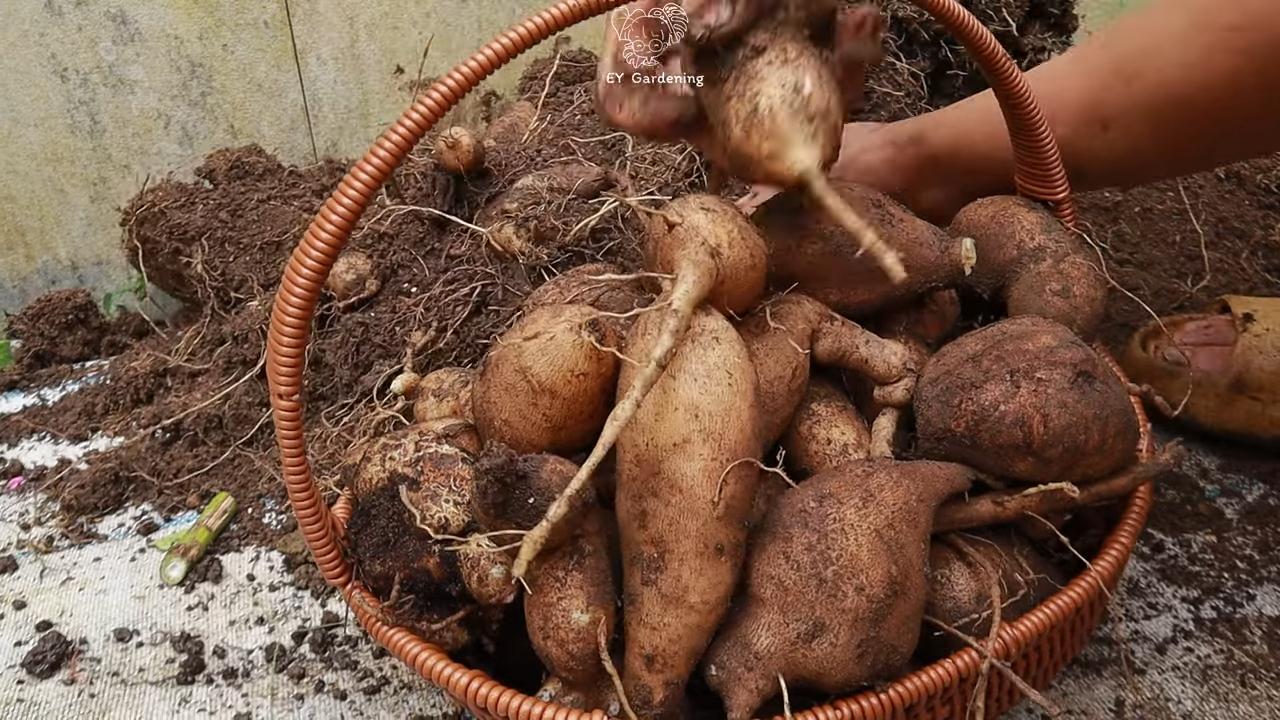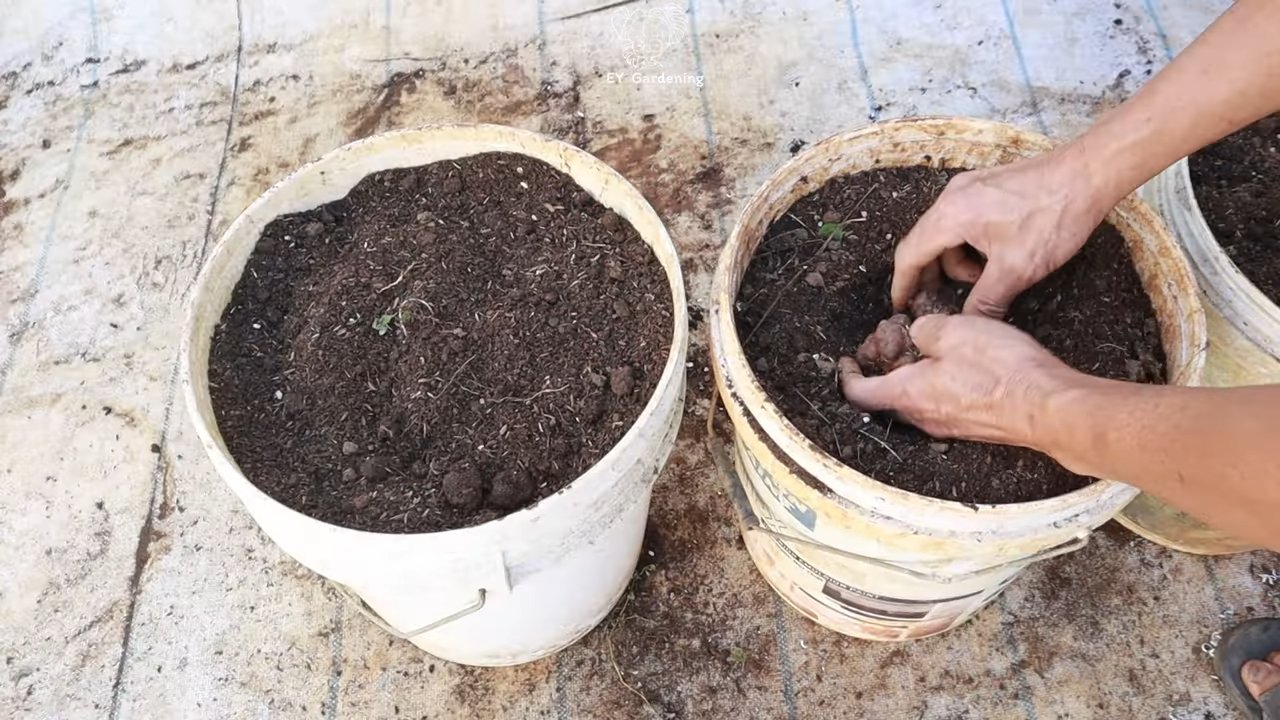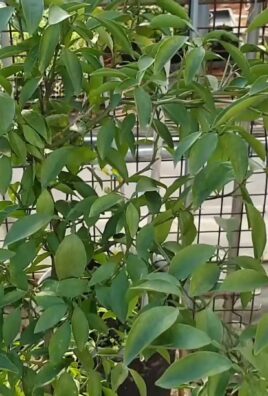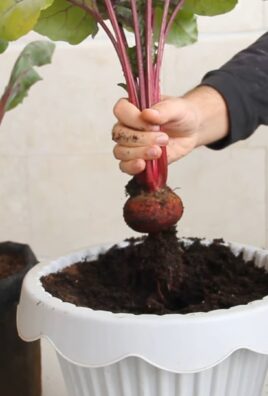Growing Yacon at Home can seem like an exotic endeavor, but trust me, it’s more achievable than you think! Have you ever dreamt of harvesting sweet, juicy tubers right from your own backyard? Imagine the satisfaction of pulling up a plant and discovering a treasure trove of delicious, low-calorie treats. This isn’t just a gardening project; it’s a culinary adventure waiting to happen!
Yacon, a South American native, has been cultivated for centuries in the Andes, where it’s prized for its crisp texture and naturally sweet flavor. It’s more than just a tasty snack; it’s a part of their rich cultural heritage. Now, you can bring a piece of that history to your own garden.
Why should you try growing Yacon at home? Well, for starters, it’s a fantastic alternative to traditional sweeteners, especially if you’re watching your sugar intake. Plus, it’s incredibly rewarding to nurture a plant from start to finish and enjoy the fruits (or rather, tubers!) of your labor. In this DIY guide, I’ll share all my secrets and tips to help you successfully cultivate this unique and delicious plant, even if you’re a beginner gardener. Get ready to dig in and discover the joys of homegrown Yacon!

Growing Yacon at Home: A Beginner’s Guide
Hey there, fellow gardening enthusiasts! Ever heard of yacon? It’s this amazing South American root vegetable that tastes like a cross between an apple and a pear, with a hint of watermelon. Plus, it’s naturally sweet and low in calories, making it a fantastic healthy treat. I’ve been growing yacon in my backyard for a few years now, and I’m excited to share my experience with you so you can enjoy this delicious and unique vegetable too!
What You’ll Need
Before we dive into the nitty-gritty, let’s gather all the supplies you’ll need. Trust me, having everything ready beforehand will make the whole process much smoother.
* **Yacon Crowns or Rhizomes:** This is the most crucial part! You can usually find these online from reputable seed suppliers or at local nurseries that specialize in unusual plants. Make sure they look healthy and firm.
* **Well-Draining Soil:** Yacon loves rich, well-draining soil. If your garden soil is heavy clay, you’ll want to amend it with compost, peat moss, or other organic matter.
* **Large Pots (Optional):** If you’re short on garden space, you can grow yacon in large containers. Choose pots that are at least 20 gallons in size.
* **Compost or Aged Manure:** This will provide essential nutrients for your yacon plants.
* **Gardening Gloves:** Protect your hands from dirt and potential irritants.
* **Shovel or Trowel:** For digging holes and transplanting.
* **Watering Can or Hose:** To keep your yacon plants hydrated.
* **Mulch (Optional):** Mulch helps retain moisture, suppress weeds, and regulate soil temperature. Straw, wood chips, or shredded leaves work well.
* **Stakes or Trellis (Optional):** Yacon plants can get quite tall, so you might want to provide some support to prevent them from falling over.
Choosing the Right Location
Yacon thrives in sunny locations with well-drained soil. Here’s what to keep in mind:
* **Sunlight:** Yacon needs at least 6-8 hours of direct sunlight per day. The more sun, the better!
* **Soil Drainage:** As I mentioned before, well-draining soil is essential. Yacon roots don’t like to sit in soggy soil.
* **Space:** Yacon plants can grow quite large, reaching up to 6-7 feet tall and 3-4 feet wide. Make sure you have enough space for them to spread out.
* **Protection from Wind:** Yacon plants can be susceptible to wind damage, so choose a location that is sheltered from strong winds.
Planting Your Yacon
Okay, now for the fun part – planting! I usually start my yacon indoors a few weeks before the last expected frost, but you can also plant them directly in the ground after the danger of frost has passed.
Starting Indoors (Optional)
1. **Prepare the Pots:** Fill small pots (about 4-6 inches in diameter) with well-draining potting mix.
2. **Plant the Crowns:** Place the yacon crowns horizontally in the pots, with the buds facing upwards. Cover them with about 1-2 inches of soil.
3. **Water Gently:** Water the pots gently to moisten the soil.
4. **Provide Warmth and Light:** Place the pots in a warm, sunny location or under grow lights.
5. **Keep the Soil Moist:** Keep the soil consistently moist, but not soggy.
6. **Transplant Outdoors:** Once the danger of frost has passed and the seedlings have developed a few sets of leaves, you can transplant them outdoors.
Planting Directly in the Ground
1. **Prepare the Soil:** Dig a hole that is about twice as wide and as deep as the yacon crown.
2. **Amend the Soil:** Mix compost or aged manure into the soil you removed from the hole.
3. **Plant the Crown:** Place the yacon crown horizontally in the hole, with the buds facing upwards. Cover it with about 1-2 inches of soil.
4. **Water Thoroughly:** Water the newly planted crown thoroughly.
5. **Mulch (Optional):** Apply a layer of mulch around the plant to help retain moisture and suppress weeds.
Caring for Your Yacon Plants
Once your yacon plants are in the ground, it’s important to provide them with the care they need to thrive.
* **Watering:** Yacon plants need consistent moisture, especially during hot, dry weather. Water deeply whenever the top inch of soil feels dry.
* **Fertilizing:** Yacon plants are heavy feeders, so fertilize them regularly with a balanced fertilizer. I like to use a liquid fertilizer every few weeks.
* **Weeding:** Keep the area around your yacon plants free of weeds. Weeds can compete with your yacon plants for nutrients and water.
* **Staking (Optional):** As your yacon plants grow taller, you may need to stake them to prevent them from falling over.
* **Pest Control:** Yacon plants are generally pest-resistant, but they can occasionally be attacked by slugs or snails. If you notice any pests, you can handpick them off the plants or use an organic pest control product.
Harvesting Your Yacon
This is the moment we’ve all been waiting for! Harvesting yacon is a rewarding experience. You’ll typically harvest in the late fall, after the first frost has killed back the foliage.
1. **Cut Back the Foliage:** Cut back the foliage to about 6 inches above the ground.
2. **Dig Carefully:** Use a shovel or garden fork to carefully dig around the base of the plant, being careful not to damage the tubers.
3. **Lift the Plant:** Gently lift the plant out of the ground.
4. **Separate the Tubers:** Separate the tubers from the crown. The tubers are the edible part of the plant.
5. **Cure the Tubers:** Cure the tubers in a cool, dry place for a few weeks. This will allow the sugars to develop and improve the flavor. I usually store mine in a cardboard box in my garage.
6. **Store the Crowns:** Save the crowns for replanting next year. Store them in a cool, moist place, such as a plastic bag in the refrigerator.
Enjoying Your Yacon
Now that you’ve harvested your yacon, it’s time to enjoy the fruits (or rather, the tubers) of your labor! Yacon can be eaten raw, cooked, or juiced.
* **Raw:** Yacon is delicious eaten raw, like an apple or pear. Simply peel the tubers and slice them into bite-sized pieces.
* **Cooked:** Yacon can be cooked in a variety of ways, such as roasting, grilling, or stir-frying. It has a slightly sweet flavor and a crisp texture.
* **Juiced:** Yacon juice is a refreshing and healthy beverage. Simply juice the tubers using a juicer.
Troubleshooting
Even with the best care, you might encounter some challenges along the way. Here are a few common problems and how to address them:
* **Slow Growth:** If your yacon plants are growing slowly, it could be due to a lack of sunlight, nutrients, or water. Make sure they are getting enough of all three.
* **Yellowing Leaves:** Yellowing leaves can be a sign of nutrient deficiency or overwatering. Check the soil moisture and fertilize if necessary.
* **Pest Problems:** As mentioned earlier, slugs and snails can sometimes attack yacon plants. Use organic pest control methods to get rid of them.
* **Rotting Tubers:** Rotting tubers can be caused by overwatering or poor drainage. Make sure the soil is well-draining and avoid overwatering.
Tips for Success
Here are a few extra tips to help you succeed with growing yacon:
* Start with Healthy Crowns: This is the most important factor for success. Choose crowns that are firm and have healthy buds.
* Amend Your Soil: Yacon loves rich, well-draining soil. Amend your soil with compost or aged manure before planting.
* Water Regularly: Yacon plants need consistent moisture, especially during hot, dry weather.
* Fertilize Regularly: Yacon plants are heavy feeders, so fertilize them regularly with a balanced fertilizer.
* Be Patient: Yacon takes a while to mature, so don’t get discouraged if you don’t see results right away.
Growing yacon at home is a rewarding experience that allows you to enjoy a unique and delicious vegetable. With a little bit of care and attention, you can successfully grow yacon in your own backyard. Happy gardening!

Conclusion
So, there you have it! Growing yacon at home is not only achievable, but it’s also a deeply rewarding experience that connects you directly to the source of your food. Forget the often-limited and sometimes pricey yacon selection at your local grocery store. Imagine harvesting your own fresh, crisp, and naturally sweet tubers right from your backyard. The satisfaction alone is worth the effort.
But beyond the sheer joy of homegrown produce, cultivating yacon offers a multitude of benefits. You control the growing conditions, ensuring your yacon is free from harmful pesticides and herbicides. You reduce your carbon footprint by eliminating transportation costs. And you gain a deeper understanding of the plant’s life cycle and the intricate processes of nature.
This DIY trick of growing yacon at home empowers you to take control of your food supply and enjoy a unique and healthy treat. The slightly sweet, apple-like flavor of yacon makes it a versatile addition to your diet. Enjoy it raw in salads, baked into chips, or even juiced for a refreshing beverage. The possibilities are endless!
Don’t be afraid to experiment! Consider these variations to personalize your yacon-growing journey:
* Container Gardening: If you’re short on space, yacon thrives in large containers. Choose a pot at least 20 gallons in size and ensure it has excellent drainage. This is a great option for apartment dwellers or those with limited garden space.
* Companion Planting: Yacon benefits from companion planting. Try planting it alongside beans, peas, or other nitrogen-fixing plants to improve soil fertility. Marigolds can also help deter pests.
* Different Varieties: While the standard yacon variety is readily available, explore different cultivars if you can find them. Some varieties may offer slightly different flavors or textures.
* Soil Amendments: While yacon isn’t overly fussy about soil, amending it with compost or well-rotted manure will provide essential nutrients and improve drainage.
* Yacon Syrup: Once you have a bountiful harvest, consider making your own yacon syrup. It’s a natural sweetener with a low glycemic index, making it a healthier alternative to refined sugar.
We wholeheartedly encourage you to embark on this yacon-growing adventure. It’s a fun, educational, and ultimately delicious experience. Remember to start with healthy rhizomes, provide adequate sunlight and water, and be patient. The rewards will be well worth the effort.
So, grab your gardening gloves, prepare your soil, and get ready to grow your own yacon. We’re confident that you’ll be amazed by the results. And most importantly, we want to hear about your experience! Share your tips, tricks, and photos with us in the comments below. Let’s build a community of yacon enthusiasts and inspire others to discover the joys of homegrown goodness. Happy growing!
Frequently Asked Questions (FAQ)
What exactly is yacon, and what does it taste like?
Yacon (Smallanthus sonchifolius) is a perennial plant native to the Andes region of South America. It’s primarily grown for its crisp, sweet-tasting tubers, which are similar in texture to an apple or pear. The flavor is often described as a blend of apple, pear, and watermelon, with a subtle sweetness. The sweetness comes from fructooligosaccharides (FOS), a type of sugar that the human body doesn’t fully digest, making yacon a lower-calorie and lower-glycemic alternative to some other sweeteners. The leaves are also edible and can be used to make tea.
When is the best time to plant yacon?
The ideal time to plant yacon is in the spring, after the last frost has passed. This allows the plant to establish itself during the warmer months and develop a strong root system before winter. If you live in a region with mild winters, you may be able to plant yacon in the fall. However, it’s essential to protect the plant from frost during its early stages of growth. Starting yacon indoors from rhizomes a few weeks before the last frost can also give you a head start.
How much sunlight does yacon need?
Yacon thrives in full sun, requiring at least 6-8 hours of direct sunlight per day. While it can tolerate partial shade, the tubers will be smaller and less sweet if it doesn’t receive enough sunlight. Choose a planting location that receives ample sunlight throughout the day. If you’re growing yacon in containers, make sure to place them in a sunny spot.
What type of soil is best for growing yacon?
Yacon prefers well-drained soil that is rich in organic matter. The soil should be loose and friable to allow the tubers to develop easily. Amend heavy clay soil with compost, well-rotted manure, or other organic materials to improve drainage and aeration. A slightly acidic to neutral soil pH (around 6.0 to 7.0) is ideal.
How often should I water yacon?
Yacon needs consistent watering, especially during dry periods. Water deeply whenever the top inch of soil feels dry to the touch. Avoid overwatering, as this can lead to root rot. During the growing season, you may need to water more frequently, especially if you’re growing yacon in containers. Mulching around the plants can help retain moisture in the soil.
How do I harvest yacon?
Yacon is typically harvested in the fall, after the foliage has died back. This usually occurs after the first frost. To harvest, carefully dig around the plant, being careful not to damage the tubers. Gently lift the plant from the ground and separate the tubers from the rhizomes. The tubers are the edible part of the plant, while the rhizomes are used for propagation.
How do I store yacon tubers?
After harvesting, yacon tubers need to be cured for a few days to a week before storing them. This allows the skin to toughen up and prevents rot. To cure the tubers, place them in a cool, dry, and well-ventilated area. After curing, store the tubers in a cool, dark place, such as a root cellar or refrigerator. They can be stored for several months if stored properly.
Can I eat yacon raw?
Yes, yacon tubers can be eaten raw. In fact, many people prefer to eat them raw because they are crisp and refreshing. Simply peel the tubers and slice them into salads, or eat them as a snack. The tubers can also be cooked in various ways, such as baking, roasting, or stir-frying.
Are there any pests or diseases that affect yacon?
Yacon is generally resistant to pests and diseases. However, it can be susceptible to slugs, snails, and aphids. These pests can be controlled with organic pest control methods, such as hand-picking, diatomaceous earth, or insecticidal soap. Root rot can also be a problem if the soil is poorly drained.
How do I propagate yacon?
Yacon is propagated from its rhizomes, which are the underground stems that produce the tubers. After harvesting, save the rhizomes for planting the following spring. Store the rhizomes in a cool, dry place over the winter. In the spring, cut the rhizomes into sections, each with at least one eye (bud). Plant the rhizome sections in pots or directly in the ground.
Is yacon a good choice for people with diabetes?
Yacon has a low glycemic index (GI) due to its high content of fructooligosaccharides (FOS). FOS are not fully digested by the body, so they have a minimal impact on blood sugar levels. This makes yacon a potentially good choice for people with diabetes. However, it’s important to consult with a healthcare professional before making any significant dietary changes.
Can I grow yacon in containers?
Yes, yacon can be successfully grown in containers. Choose a large container (at least 20 gallons) with good drainage. Use a well-draining potting mix that is rich in organic matter. Water regularly and fertilize every few weeks with a balanced fertilizer. Place the container in a sunny location.
What are the health benefits of eating yacon?
Yacon is a good source of fiber, potassium, and antioxidants. The FOS in yacon can promote the growth of beneficial bacteria in the gut, which can improve digestion and boost the immune system. Yacon may also help lower cholesterol levels and improve blood sugar control. However, more research is needed to confirm these potential health benefits.





Leave a Comment